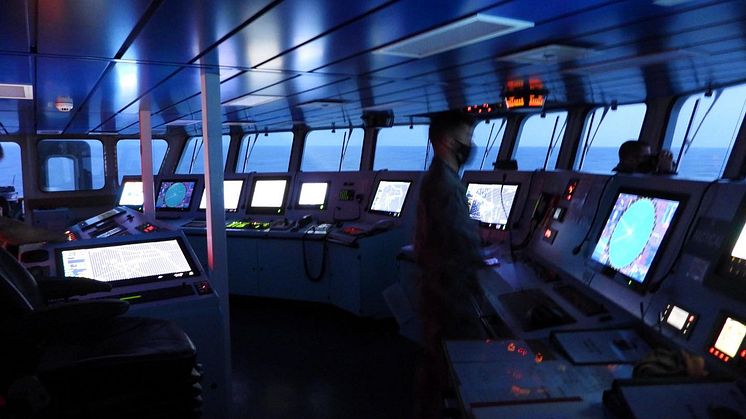
Press release -
Ireland advances joint operation of SitaWare at sea and in the air
The Defence Forces of Ireland (DFI) have continued to leverage their suite of SitaWare software, including SitaWare Headquarters and SitaWare Frontline, to reinforce the nation’s sovereign and economic interests, and facilitate joint operations.
The deployment of the SitaWare solutions has helped to create a common situational awareness (SA) platform for the DFI, as the three service branches undertake missions close to Ireland and overseas. This creates challenges for commanding units at a distance, as well as the timely gathering and dissemination of intelligence to support responsive actions.
“The value of a single SA platform across the entire force greatly outweighs any disadvantages of the small tools that are bespoke to an actual domain. Look at the overall effect that can be delivered, because being on the same SA platform, and on the same network, means you can seamlessly share the information to the users who need it,” Commander Brian Mathews of the Irish Naval Service said.
This was one of the rare times where the technology changed the Naval Service’s concept of operations, Mathews said, as the force seamlessly moved to a network-enabled approach to operations through the deployment of SitaWare Headquarters. This implementation was eased by the Irish Army’s use of the system, with the Naval Service wanting to operate easily with the land forces.
Deployments by the Irish Naval Service of the SitaWare suite has ranged from the force’s helicopter patrol and offshore patrol vessels, down to rigid hull inflatable boats (RHIBs) used for boarding. Blue force tracking and sharing SA in real-time or near-real-time also helps to facilitate interoperability between the different forces involved in operations.
“There was some concern from the ships’ captains about the operational commander ashore seeing all the activity on the ship, all the time,” Mathews said. “But because the operational commander can see the picture, the ships’ captains don’t have to keep reverting back for approval.”
“As a result, we’ve been able to push the decision making from the centre, to the edge. A ship’s captain can now say ‘I intend doing this today’ based on the sea conditions or the activity in their area, with the operations centre monitoring and providing support as necessary,” Mathews added.
Filtering and fusion
Track correlation has also helped to fuse data from various inputs into a single layer, removing potential duplication of targets within the situational picture. The combination of multiple feeds into a single view allows for smarter operational planning and deployment of assets, resulting in the more efficient use of resources.
Smart filtering also allows the anonymisation of sensor feeds, meaning that previously classified SA pictures could be shared with civilian agencies without compromising the status or location of the Naval Service’s vessels.
“What I can then do is bring different feeds from multiple locations together into one layer, correlate them, and export it so it’s all anonymised,” Mathews said.
Increasing airborne intelligence gathering and dissemination
DFI is continuing to increase its fielding of SitaWare to support information and intelligence dissemination to a wide variety of stakeholders. The organisation announced in September 2021 that it would be fitting its fleet of four Pilatus PC-12NG aircraft with SitaWare Headquarters and Frontline. Three of the aircraft are configured as SPECTRE platforms, providing an advanced Intelligence, Surveillance, Target Acquisition, and Reconnaissance (ISTAR) picture to the Defence Forces. A fourth aircraft is configured as a utility platform and is also equipped with SitaWare Headquarters and Frontline.
SitaWare is also set to be integrated on the two Airbus C295 Persuader aircraft that are due to enter service with the Irish Air Corps in March 2023, with these platforms primarily focusing on maritime patrol duties.
According to Captain Paul Shorte of the DFI’s CIS Branch of the DCOS Operations Division, “When we went through the design phase for the C295, we went through Airbus’ FITS workstation system to see what can we actually get out of the tactical system on board the aircraft. On our current fleet of CN235 aircraft, no flight information was shared until after the aircraft had landed. That means it could be 10-11 hours before the information gathered would be available to other users in the organisation. We needed to maximise the effect and the capability that’s generated from this aircraft when they’re in the sky, because once they land that information is too old.”
The platform will also utilise sensors and radars that can collect signals for ADS-B aircraft identification and automatic identification system (AIS) for ships, as well as primary radars that can identify ships and aircraft not transmitting on a recognised transponder channel. These can then be blended into a common operating picture with track correlation and analysis for distribution to other stakeholders to identify objects of interest.
Combining these new sensor feeds will create a relatively crowded SA picture, and the ability to intelligently filter these for distribution and dissemination to military and civilian customers through the new smart filtering solution will also be beneficial, Mathews said.
For more information please contact Charles Forrester, Defence Communications Manager, at charles.forrester@systematic.com.
Topics
Categories
Established in 1985, Systematic A/S develops software and system solutions to customers in both the public and private sector. A common feature of these customers is a need to integrate, compare and analyse large volumes of complex data, and to generate an overview that allows decision-making based on a solid foundation, often in critical situations.
Systematic’s software solutions are used in healthcare, intelligence, law enforcement, defence, education, renewable energy and utilities industries.
Today, Systematic is the largest privately owned software company in Denmark, with solutions sold to customers in 50+ countries. More than 1 million people worldwide use Systematic solutions and services every day.
Systematic has approximately 1,100+ employees and is headquartered in Aarhus, Denmark, with offices in Copenhagen, Australia, Canada, Finland, Germany, New Zealand, Sweden, the United Arab Emirates, the United Kingdom, Romania and the United States. www.systematic.com

